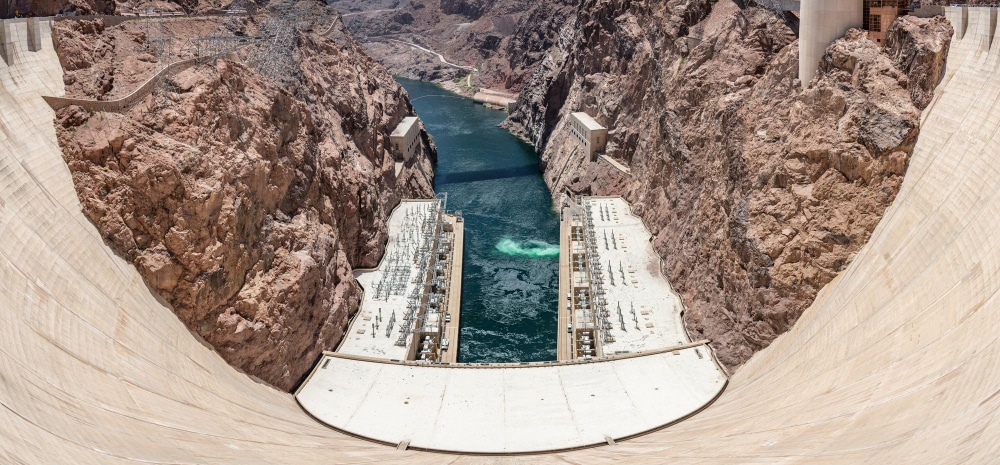
Introduction & Historical Background
The Hoover Dam, an awe-inspiring symbol of American engineering prowess, is an iconic structure located near Las Vegas, Nevada. Named after President Herbert Hoover, the dam was constructed during the Great Depression to provide much-needed jobs and control flooding of the Colorado River. Today, it is a popular tourist destination that attracts millions of visitors each year. The dam’s fascinating history, impressive architecture, and stunning views make it a must-see attraction for anyone visiting the Las Vegas area.
The Hoover Dam, initially known as the Boulder Dam, was constructed between 1931 and 1936 under President Herbert Hoover’s administration. The primary purpose of the dam was to control the flow of the Colorado River, which was prone to destructive floods, and to provide water and electricity to the burgeoning population of the southwestern United States. The dam’s construction was a massive undertaking, with over 21,000 workers employed during the five-year project. The result was a monumental structure that has become synonymous with American ingenuity and innovation.
Dam’s Design and Construction
The Hoover Dam is an arch-gravity dam, standing 726 feet tall and spanning 1,244 feet across the Colorado River. This design combines the strength of an arch dam with the weight of a gravity dam, allowing it to withstand tremendous pressure from the water behind it. The dam’s construction required more than 3.25 million cubic yards of concrete, enough to pave a two-lane road from San Francisco to New York City.
One of the most impressive features of the Hoover Dam is its hydroelectric power plant. The dam generates electricity through 17 turbines, which are fed by water from Lake Mead, the reservoir created by the dam. The power plant has a generating capacity of over 2,000 megawatts, supplying electricity to Nevada, Arizona, and California. The electricity generated by the Hoover Dam played a crucial role in the development of the American Southwest and continues to be an essential source of clean, renewable energy.
Touring the Hoover Dam
A visit to the Hoover Dam offers a variety of experiences for tourists, including guided tours, educational exhibits, and breathtaking views of the surrounding landscape. The Hoover Dam Visitor Center, managed by the U.S. Bureau of Reclamation, serves as the starting point for all tours and provides valuable information about the dam’s history, construction, and ongoing operations.
Guided tours of the dam are available daily, with knowledgeable guides providing detailed information about the dam’s construction and engineering. The Powerplant Tour takes visitors inside the dam to see its massive turbines and generators, while the Dam Tour provides a more comprehensive look at the structure’s exterior and interior, including the dam’s crest and inspection tunnels.
The Hoover Dam’s panoramic views are a highlight for many visitors. The Mike O’Callaghan-Pat Tillman Memorial Bridge, completed in 2010, offers a unique vantage point from which to view the dam. The pedestrian walkway on the bridge, which stands over 900 feet above the Colorado River, provides stunning views of the Hoover Dam, Lake Mead, and the surrounding landscape. The bridge itself is an impressive feat of engineering, featuring the longest concrete arch in the Western Hemisphere.
Visitors can also take in the beauty of Lake Mead, the largest reservoir in the United States by volume, which stretches over 110 miles behind the dam. The Lake Mead National Recreation Area offers various recreational activities, such as boating, fishing, and hiking, making it a perfect complement to a visit to the Hoover Dam.
Environmental Impact and Sustainability
The Hoover Dam has played a significant role in water management and power generation in the American Southwest for nearly a century. While the dam has undeniably contributed to the region’s growth and development, it has also raised concerns about its environmental impact. The construction of the dam and the creation of Lake Mead led to the loss of habitats for various plant and animal species, as well as the disruption of the natural flow of the Colorado River. In recent years, water levels in Lake Mead have been steadily declining due to prolonged droughts and increased water consumption in the region.
In response to these concerns, the U.S. Bureau of Reclamation and other stakeholders have implemented various measures to promote sustainable water use and minimize the dam’s ecological footprint. These efforts include water conservation programs, improved efficiency in water distribution, and habitat restoration projects. The Hoover Dam’s hydroelectric power plant also continues to provide a vital source of clean, renewable energy, reducing the region’s reliance on fossil fuels and contributing to climate change mitigation efforts.
Tips for Visiting the Hoover Dam
To make the most of your visit to the Hoover Dam, consider the following tips:
- Plan ahead: The Hoover Dam is a popular tourist destination, so it’s essential to book guided tours in advance, especially during peak season. Additionally, the dam may have scheduled maintenance or other restrictions, so be sure to check the U.S. Bureau of Reclamation website for updates before your visit.
- Dress appropriately: The temperature inside the dam can be significantly cooler than outside, so it’s advisable to wear layers to ensure comfort during your tour. Comfortable, closed-toe shoes are also recommended as the tours involve walking on uneven surfaces.
- Allow enough time: A visit to the Hoover Dam can easily take half a day, especially if you’re participating in a guided tour. Be sure to allocate enough time to explore the Visitor Center, take in the views, and enjoy the surrounding attractions.
- Bring a camera: The Hoover Dam offers numerous photo opportunities, from the dam’s impressive structure to the breathtaking views of Lake Mead and the Colorado River. Don’t forget to capture the memories of your visit.
- Combine your visit with nearby attractions: The Hoover Dam is located approximately 30 miles from Las Vegas, making it an easy day trip from the city. Consider combining your visit with other nearby attractions, such as the Lake Mead National Recreation Area, the Valley of Fire State Park, or the Red Rock Canyon National Conservation Area.
Hoover Dam Summary
The Hoover Dam is a testament to American engineering and innovation, standing as a symbol of progress and determination. Its fascinating history, coupled with its ongoing role in water management and power generation, makes it a must-see attraction for visitors to the Las Vegas area. Whether you’re interested in engineering marvels, stunning natural landscapes, or simply looking for an educational and entertaining experience, the Hoover Dam offers something for everyone.

